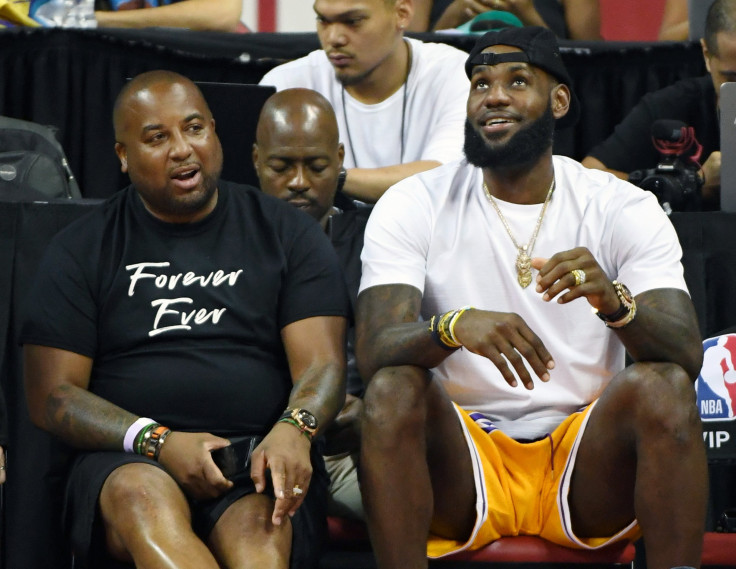Lakers Starting Lineups 2018-2019: Breaking Down LeBron James' Teammates After A Busy Free-Agent Offseason

The Los Angeles Lakers had a dizzying offseason. After the free-agent addition of LeBron James, team president Magic Johnson and general manager Rob Pelinka went to work to complete a roster composed of mostly veterans on expiring contracts — a strategy that keeps L.A. in contention for a top free agent next summer but not at the expense of seriously competing in the deep Western Conference.
This overhauled roster brings opportunities, competition and perhaps some confusion as to the favored pieces that should surround James. Though the new signees are expected to contribute right away, the Lakers also have some impressive young holdovers from an encouraging 2017-18 season, as well as a few workhorse players drafted in June.
While James will no doubt lead the Lakers in average minutes played, the players who directly follow him in the category remains a mystery. Adding to the uncertainty is Pelinka's probable interest in completing a blockbuster trade before the trade deadline in February and with the Lakers lacking in pure shooters.
The trend by NBA teams in recent years has been to mix up the starting lineups. Last season, the Lakers had 15 players who started at least one game and even the champion Golden State Warriors, with their star-studded lineup, had 14 players with at least four starts. With so much depth, it's fair to assume head coach Luke Walton will tinker a lot with the starting lineup and who will be on the floor during crucial stretches.
Indeed, there will be plenty of player rotation in the upcoming season.
First Off... Who's Back, Who's New And Who's Out?
There are currently 21 players on the roster but that will be significantly trimmed before the start of the season.
RETURNING: Lonzo Ball, Kentavious Caldwell-Pope, Alex Caruso, Luol Deng, Josh Hart, Andre Ingram, Brandon Ingram, Kyle Kuzma, Gary Payton II, Travis Wear, Ivica Zubac.
IN: Michael Beasley, Isaac Bonga, Jeffrey Carroll, LeBron James, JaVale McGee, Svi Mykhailiuk, Rajon Rondo, Lance Stephenson, Moritz Wagner, Jonathan Williams.
OUT: Vander Blue, Andrew Bogut, Corey Brewer, Thomas Bryant, Jordan Clarkson, Tyler Ennis, Channing Frye, Nigel Hayes, Brook Lopez, Larry Nance, Julius Randle, Isaiah Thomas, Derrick Williams.
So, It's "In With The New?"
It's scary how many talented players that are 25 years old or younger on this squad. If Walton feels like it, he can stick with a youth movement for most of the regular season.
James might find himself surrounded by Brandon Ingram and 7-foot rookie Moritz Wagner in the frontcourt, along with Lonzo Ball and Kentavious Caldwell-Pope in the backcourt. Such a lineup would allow for good ball movement and open up opportunities for more three-point shots.
But that's not where it ends. Walton can also continue giving substantial minutes to breakout forward Kyle Kuzma and even have him on the court at the same time with James and Ingram. Walton can also fit in more time for defensive big man Ivica Zubac, as well as rapidly improving second-year guard Josh Hart. Then there's Isaac Bonga and Svi Mykhailiuk — two versatile rookies who could find themselves on the court if they impress in the preseason.
Just don't count on it. It's unlikely Walton would only stick with young players while the veterans mostly sat on the bench. But it's interesting and comforting to know he has that option.
...Or Is It "In With The Old?"
It may not be a bad move for Walton to play veterans for important stretches of regular-season games. Alongside James could be forward Michael Beasley, who is coming off a solid season with the New York Knicks, and joined in the frontcourt by the defensive presence of JaVale McGee. In the backcourt, 12-year veteran Rajon Rondo and 27-year-old Lance Stephenson are capable of knocking down shots and also playing tough defense.
Yes, Luol Deng is out of favor and seems certain to move on, but the 33-year-old could still find his way onto the court to give the Lakers some quality minutes. Deng is basically coming off a full year of rest and in his last full season (2015-16), he averaged a respectable 12.3 points per game on 45.5 percent shooting.
Rest will be a key issue with the veterans. An 82-game season is often grueling, so expect experienced players like Rondo, who played in 65 games and averaged 26.2 minutes last season, to intermittently get extended minutes on the bench to preserve his fitness for the postseason.
Overall, this is a solid group of experienced players that should fit well around James.
Which Four Other Players Will Play The Most Minutes?
Though he seems most comfortable at James' small forward spot, Ingram seems like a lock to see significant time. After that, it gets a bit hazy. Ball can expect to see slightly more minutes than Hart and Rondo, while Caldwell-Pope will probably be the preferred shooting guard.
Do the Lakers need a traditional center getting about 30 minutes a night? Probably not. Centers McGee and Zubac can expect erratic minutes. In small lineups, Walton will likely favor Beasley a bit more than Kuzma for rebounding purposes.
Overall, how Walton divides up the minutes may seem inconsequential. James is the centerpiece for this team and there will be ample opportunity for players to prove themselves and for Walton to keep the squad fit for the playoffs.
© Copyright IBTimes 2024. All rights reserved.






















